Kato's Unitrack is literally the connective agent that makes T-Trak work. But it is comparatively expensive.
Now for your typical two-track module, the cost of the track isn't too significant compared to the overall outlay of a module... but once you start doing four—or in my case six—tracks (as extensions for my yard module) you're starting to talk about a pretty good chunk of change. So I was ready to entertain that un-T-Trak option of flex track use.
Update: Okay, so "un-T-Trak" is a bit off the mark. Having dropped in on the recently redone t-trak.org (which is nicely improved, go have a look if you haven't been there in a while) I see the language there revised to explicitly point out that only the edges of modules need to be Unitrack... and certainly as new T-Trak-related sites show up in online searches, the practice of using flex-track is clearly quite prevalent. So while I've informally been keeping to Unitrack-only configurations to keep things easy for entry-level assembly, the T-Trak world has been moving on. All goodness, I think.
There is the fact that flex track allows more flexibility—no pun intended—in terms of how track is laid, so configurations that would have been tedious or outright impossible with Kato track alone may be more easily accomplished with flex, opening up more possibilities. From an operations standpoint, flex track is longer, meaning fewer rail joints, with all that entails: electrical flow, derailment potential, and the like.
Anyway, this is an idea I had been tossing around for a bit, but not quite needing to make the leap, I hadn't pursued too aggressively. The crux is how to integrate the Unitrack—necessary at the module ends to make those robust connections—with the flex track to fill the interior of the right-of-way.
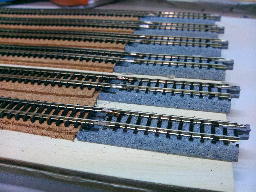 |
| Six tracks using S62Js from the Kato 20-045 pack. This works, but it's more work, and the S62J pieces aren't really necessary. |
There had been discussions of chopping Unitrack, of using the track converters, and so on. Having a few of the S62J conversion tracks (Kato 20-045) on hand, I tried this option. It worked reasonably well. But having six tracks to do, and needing another two S62J to complete the module, I found myself in a quandary... a pack of two such connectors was comparatively expensive, when they were available. (These aren't frequently-used bits of track, so the Local Hobby Shop didn't always have them in stock.)
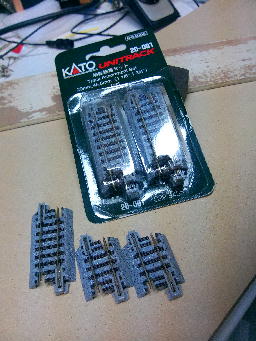 |
| A package of Kato 20-091, with lots of great short bits of track |
Fortunately, a moment's inspiration resulted in what has turned out to be a superior solution, both in terms of cost and effectiveness. The Kato Unitrack 20-091, "Short Track Assortment" comes with 8 short 29mm bits of track and two more 45.5mm pieces, all for a fairly reasonable price. You get 8-10 joints; two packs are enough to do 5 two-track modules.
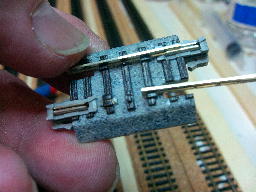 |
| Gently pulling off the Kato rail... |
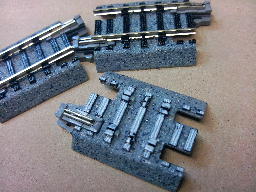 |
| ... and removing one UniJoiner ... |
So here's the deal: by gently pulling along the length of the 29mm bits of rail with needle-nose pliers, you can tug them free, leaving the roadbed/tie casting intact. Do this carefully, to not break any of the molded fasteners. I set the bits of rail aside for other uses: roadside scrap, wing-rails, etc. I also take the opportunity to repaint the black "wood" ties a light gray to look more like concrete. Yet another freebie: you'll only be using one of the two UniJoiners per bit of track, so you'll have extras... which you will need over time, so set these aside, too.
Now, Unitrack is essentially code-80 rail, so code-80 N gauge flex track has the same rail profile. The idea here is that you liberate the last 29mm (or so) of flex track ties and gently slide the exposed rail into the 29mm roadbed, again being careful not to damage the fasteners. (Using a file to gently remove any burrs from the flex track makes this a bit easier.)
Do this at both ends of a module, and you can get away with no rail joints—or soldering—whatsoever. In my case, I did some some triple-length yard modules, and since the flex track was only 30 inches, I did have to solder some rail; no biggie, but if you don't like soldering, stick with single- or double-length modules—shorter than the length of flex track, anyway—and you should never need to warm any solder. Once you've test-fitted both ends of the module, put a drop of glue under the rail to keep the rail from slipping.
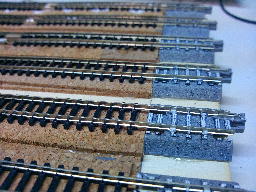 |
| The final result: no soldered joints. Also note the cork that the flex track rests on. |
One detail to consider, though, is that flex track does not have built-in roadbed, and (at least for the brand of flex track I used) "floats" about ⅛" above the module top, owing to the Kato track's roadbed height. This is easily fixed with sheet cork cut to width. Cork roadbed has also been used historically to make trains run more quietly, and this has proven to be true here as well.
My local hardware store sells sheets of the stuff, and I cut it into 1 inch strips (the width of Kato Unitrack's roadbed) which I glue down onto the module where the flex-track will go, leaving 28mm free at the ends for the 29mm bit of roadbed. The cork is also flexible enough to be shaped into gentle curves, if needed. You can, of course, also use genuine cork roadbed.
Use Aileen's Tacky Glue (or similar) to glue the cork onto the module, and the flex track onto the cork. Use E-6000 to glue down the little Unitrack ends, for a more durable but slightly elastic bond needed to survive the stresses that connecting and disconnecting impart on the track.
| What you'll Need |
| Flex Track code 80 |
| 20-091 Track Assortment |
| Rail Nippers (Xuron, or similar) |
| Pliers (Needle-nose) |
| Cork Sheet, ⅛" or ¹⁄₁₆" thickness |
| Utility Knife |
| Wood glue or similar |
| E6000 adhesive |



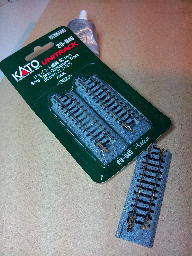
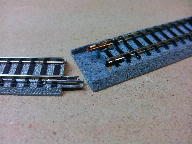
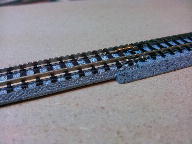

 Generate a QR code link to this page
Generate a QR code link to this page